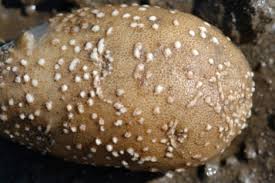We tried potatoes for the first time last year with some leftover seed potatoes a friend had given us and thought it would be worth a shot. They did pretty well, even though they were small and we had enough to keep up with, having potatoes a couple nights a week. This year, we had big plans. We got more seed potatoes and had plans of needing a root cellar and were wondering, just what would we do with all the potatoes!? Well, we won’t have any trouble and I’m glad we didn’t start construction on the root cellar just yet.
We thought we were waiting until the right time to harvest. The vines had just bloomed and started to die. Once the plant blooms, the energy is being devoted to the production of the flower and it is unlikely that any more energy will be diverted to growing potatoes. Unfortunately, this did not occur until after the week of the non-stop rains we had. Potatoes, like most other vegetables do well with consistent watering, meaning a consistent amount of rain each week, not consistently raining for a week, as we experienced! However, we know there is nothing we can do to control mother nature and we obviously didn’t have our potato bed prepared correctly as it must have needed much more drainage.
When we started digging the potatoes up, we had many smaller sized potatoes that were nice and firm, but unfortunately, our best-sized potatoes had rotted in the ground before we had a chance to dig them up. We also noticed that even the smaller potatoes were covered with what looked like white bumps all over. The white bumps are actually called lenticels. Lenticels are special pores in the plant tissue that allow oxygen exchange with the outside world, allowing the potatoes to “breathe.” The large amount of moisture we have been receiving caused the lenticels to swell and therefore become visible. They may also appear in humid storage environments and as long as there are no other signs of problems of things like fungal or bacterial disease, the potatoes remain safe to eat.
However, the presence of the lenticels tells us a lot about the quality of our soil. We obviously received an above average amount of moisture recently and even well draining soil would be wet, but we must work to increase the drainage of our potato area in the future. It also may be that we need to do an above ground bed or plant the potatoes in large containers
Good luck to any fellow potato growers and if you have some of the same problems we had and need more suggestions for increasing drainage to your garden, please call the office, stop in or email pye.13@osu.edu

